Transcription of Standard of Care: Physical Therapy Management of the ...
1 Standard of care : Physical Therapy Management of the Patient with Peripheral Vascular Disease Copyright 2020 The Brigham and Women's Hospital, Inc., Department of Rehabilitation Services. All rights reserved 1 Department of Rehabilitation Services Physical Therapy Standard of care : Physical Therapy Management of the Patient with Peripheral Vascular Disease Case Type / Diagnosis: Vascular Diseases Practice Patterns Include: 4J Impaired Motor Function, Muscle Performance, Range of Motion, Gait, Locomotion, and Balance Associated with Amputation 6B Impaired Aerobic Capacity/Endurance Associated with Deconditioning 7A Primary Prevention/Risk Reduction for Integumentary Disorders 7B Impaired Integumentary Integrity Associated with Superficial Skin Involvement ICD 10 Codes Include: to Diabetes Mellitus to Atherosclerosis Varicose veins, varices, post-thrombotic syndrome to I and I96 to Other disorders of the circulatory system to Venous Insufficiency NOS Introduction.
2 This Standard of care provides guidelines for the Management of individuals with vascular disease and its many symptoms and sequelae. Vascular disease is separated into two general categories, Arterial and Venous. Both types of vascular disease may impact all organ systems and affect function and quality of life. Peripheral Artery Disease (Peripheral Arterial Occlusive Disease) Peripheral arterial disease (PAD) most commonly occurs when atherosclerotic plaques produce localized stenosis of the arterial lumen. The atherosclerotic plaque is comprised of fibrous tissue, smooth muscle cells, cholesterol, microphages, and platelets.
3 Atherosclerotic plaque lesions can vary in structure and progression, resulting in variability in symptom The high prevalence of peripheral vascular disease (PVD) has important implications for mobility and Physical Therapy as PAD has been linked to increased fall In addition, Standard of care : Physical Therapy Management of the Patient with Peripheral Vascular Disease Copyright 2020 The Brigham and Women's Hospital, Inc., Department of Rehabilitation Services. All rights reserved 2 individuals with PAD often experience vascular involvement in other organ systems such as the heart. coronary artery disease, and the brain, cerebrovascular disease, leading to increased risk of myocardial infarction and stroke.
4 Predisposing risk factors for PAD include smoking, diabetes, hypertension, hypercholesteremia and male gender. The most common symptom of mild to moderate PAD is intermittent claudication, defined as walking-induced pain, cramping, aching, tiredness, heaviness in one or both legs especially calves, that does not go away with continued walking and is relieved with rest .10 Early detection of PAD is a crucial step in avoiding the need for surgical intervention. Early PAD is often diagnosed using the ankle-brachial index (ABI). This is a non-invasive test that compares the systolic blood pressure (SBP) at the ankle to the brachial SBP (ankle SBP/brachial SBP = ABI).
5 An ABI less than is suggestive of PAD. Non-surgical Management includes exercise, medication, and changes in lifestyle to minimize risk ,17 Smoking cessation has the most significant impact, as evidence has shown it can stop PAD progression and improve circulation. In addition, many studies show that regular exercise, including active and resistive range of motion exercises and walking, leads to quantifiable improvements in quality of life, community-based functional capacity and walking ,11 Exercise and ambulation may prevent or slow the progression of PAD. Unfortunately, individuals with PAD and resulting claudication often have a decrease in activity in response to discomfort.
6 They also may have the incorrect belief that walking can cause them injury. This decrease in activity causes faster progression of The goal of surgery is to regain adequate blood flow thus relieving pain, improving function and quality of life and prolonging patient Unfortunately, most patients with lower limb ischemia have a heavy disease burden related to their comorbidities. The 5-year survival rate is The present medical outcomes are seen in those with PAD involving the calf or foot in conjunction with diabetes, often requiring surgical Venous Disease Venous insufficiency occurs when the venous system is unable to provide adequate antegrade blood flow back to the heart, venous return, and fails to prevent retrograde flow into the extremities, leading to peripheral Venous disease can manifest in changes to vasculature, including superficial varicose veins and chronic venous stasis which affects the deeper veins.
7 Deep vein thrombosis (DVT) most commonly result in changes to the deep vein tissue. Reflux disease due to venous valvular incompetence accounts for the majority of chronic venous insufficiency (CVI). The venous valve leaflets can become thickened, shortened or embedded in scarred vein wall during the process of phlebetic inflammation. This process leads to the vein becoming rigid and thickened with fibrious material crossing the Venous disease can be congenital or of unknown etiology. Risk factors for venous disease include pregnancy and hormone Physical symptoms of venous disease include Standard of care : Physical Therapy Management of the Patient with Peripheral Vascular Disease Copyright 2020 The Brigham and Women's Hospital, Inc.
8 , Department of Rehabilitation Services. All rights reserved 3 dependent ankle edema, subcutaneous fibrosis, brown skin discoloration known as hemosiderin staining, eczema, and dilation of subcutaneous veins. Arterial pulses are usually present. Disease which occurs below the knee appears more commonly in the more severe cases of venous insufficiency. Severe CVI often includes the development of chronic, difficult to heal, weeping Typically, the symptoms of CVI can be managed nonsurgically. Treatment focuses on leg elevation and compression to decrease edema, the Management of infected ulcers with local wound care such as debridement using pulsatile lavage or topical enzymatics, and antibiotics.
9 The ultimate goals are to heal and/or prevent ulcers and preserve a functional lifestyle. Surgical intervention is mostly focused on Management of venous stasis ulcers with irrigation/debridement and skin grafting. The systemic nature of vascular disease makes any part of the body susceptible to insult, including the upper extremities. Individuals with renal disease requiring dialysis are at the highest risk for upper extremity involvement as their dialysis access is most commonly located in their arms. These grafts, most often a polytetrafluorethylene or PTFE graft, are at high risk for clotting and infection, due to the synthetic material used and because of the dialysis patients comorbidities.
10 These thrombi often require surgery such as thrombectomy or dialysis access revision. Less frequently, upper extremities can require the same interventions as lower extremities, such as bypass grafts or wound Management . Venous disease can manifest as deep vein thrombosis, which is the most common cause of secondary venous disease. Conversely venous stasis can cause DVTs as it decreases the clearing of activated coagulation factors which leads to clot Symptoms of DVTs include skin that is warm to the touch, blue, brown, or red skin discoloration, dependent edema, and pain with palpation. There are several types of DVT.









